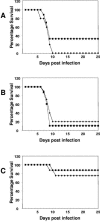Expression of hemagglutinin esterase protein from recombinant mouse hepatitis virus enhances neurovirulence
- PMID: 16306577
- PMCID: PMC1316009
- DOI: 10.1128/JVI.79.24.15064-15073.2005
Expression of hemagglutinin esterase protein from recombinant mouse hepatitis virus enhances neurovirulence
Abstract
Murine hepatitis virus (MHV) infection provides a model system for the study of hepatitis, acute encephalitis, and chronic demyelinating disease. The spike glycoprotein, S, which mediates receptor binding and membrane fusion, plays a critical role in MHV pathogenesis. However, viral proteins other than S also contribute to pathogenicity. The JHM strain of MHV is highly neurovirulent and expresses a second spike glycoprotein, the hemagglutinin esterase (HE), which is not produced by MHV-A59, a hepatotropic but only mildly neurovirulent strain. To investigate a possible role for HE in MHV-induced neurovirulence, isogenic recombinant MHV-A59 viruses were generated that produced either (i) the wild-type protein, (ii) an enzymatically inactive HE protein, or (iii) no HE at all (A. Lissenberg, M. M. Vrolijk, A. L. W. van Vliet, M. A. Langereis, J. D. F. de Groot-Mijnes, P. J. M. Rottier, and R. J. de Groot, J. Virol. 79:15054-15063, 2005 [accompanying paper]). A second, mirror set of recombinant viruses was constructed in which, in addition, the MHV-A59 S gene had been replaced with that from MHV-JHM. The expression of HE in combination with A59 S did not affect the tropism, pathogenicity, or spread of the virus in vivo. However, in combination with JHM S, the expression of HE, regardless of whether it retained esterase activity or not, resulted in increased viral spread within the central nervous system and in increased neurovirulence. Our findings suggest that the properties of S receptor utilization and/or fusogenicity mainly determine organ and host cell tropism but that HE enhances the efficiency of infection and promotes viral dissemination, at least in some tissues, presumably by serving as a second receptor-binding protein.
Figures







References
-
- Brian, D. A., B. G. Hogue, and T. E. Kienzle. 1995. The coronavirus hemagglutinin esterase glycoprotein, p. 165-179. In S. G. Siddell (ed.), The coronaviridae. Plenum Press, New York, N.Y.
-
- Cavanagh, D. 1995. The coronavirus surface glycoprotein, p. 73-113. In S. G. Siddell (ed.), The coronaviridae. Plenum Press, New York, N.Y.
Publication types
MeSH terms
Substances
Grants and funding
LinkOut - more resources
Full Text Sources

